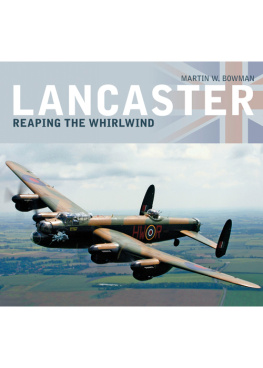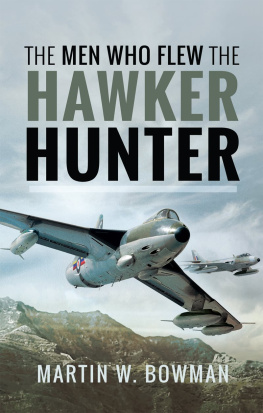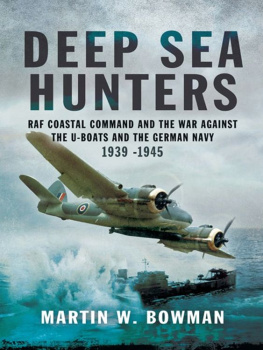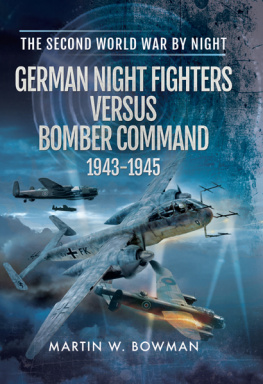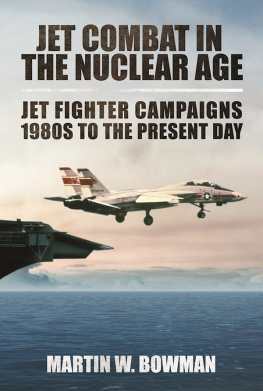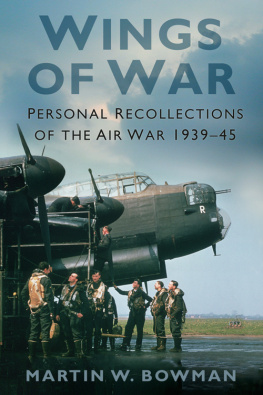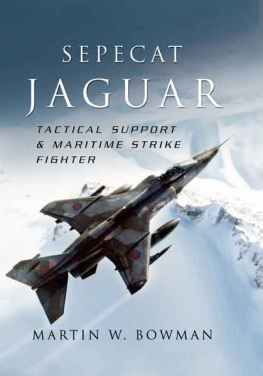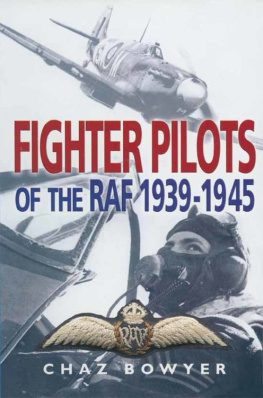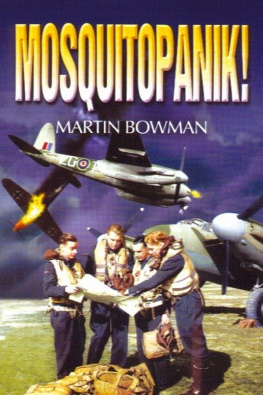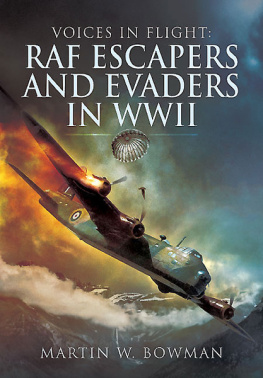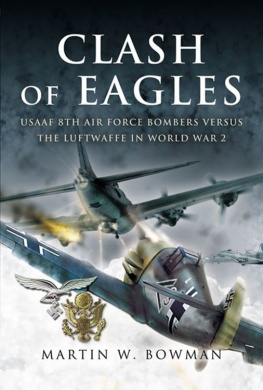First Published in Great Britain in 2015 by
Pen & Sword Aviation
an imprint of
Pen & Sword Books Ltd
47 Church Street, Barnsley, South Yorkshire S70 2AS
Copyright Martin W Bowman, 2015
ISBN: 978 1 78383 192 0
PDF ISBN: 978 1 47386 572 3
EPUB ISBN: 978 1 47386 571 6
PRC ISBN: 978 1 47386 570 9
The right of Martin W Bowman to be identified as author of this work has been asserted by him in accordance with the Copyright, Designs and Patents Act 1988.
A CIP catalogue record for this book is available from the British Library.
All rights reserved. No part of this book may be reproduced or transmitted in any form or by any means, electronic or mechanical including photocopying, recording or by any information storage and retrieval system, without permission from the Publisher in writing.
Typeset in 10/12pt Palatino
by GMS Enterprises
Printed and bound in England by
CPI Group (UK) Ltd, Croydon, CR0 4YY
Pen & Sword Books Ltd incorporates the Imprints of Pen & Sword Aviation, Pen & Sword Family History, Pen & Sword Maritime, Pen & Sword Military, Pen & Sword Discovery, Wharncliffe Local History, Wharncliffe True Crime, Wharncliffe Transport, Pen & Sword Select, Pen & Sword Military Classics, Leo Cooper, The Praetorian Press, Remember When, Seaforth Publishing and Frontline Publishing.
For a complete list of Pen & Sword titles please contact
PEN & SWORD BOOKS LIMITED
47 Church Street, Barnsley, South Yorkshire, S70 2AS, England
E-mail:
Website: www.pen-and-sword.co.uk
Contents
David Masters
An unidentified Pilot Officer RAF
Captain John R. Tex McCrary
Captain John R. Tex McCrary
W. Pelham-Groom
David Masters
David Masters
David Masters
David Masters
Hector Bolitho
Philip Burden
A Group Captain of Fighter Command
Gerald Bowman
Laddie Lucas
Captain John R. Tex McCrary
David Masters
David Masters
Acknowledgements
I am thankful to all the contributors for their words and photographs.
Thanks also go to my fellow author, friend and colleague, Graham Simons, for getting the book to press ready standard and for his detailed work on the photographs; to Pen & Sword and in particular, Laura Hirst; and Jon Wilkinson, for his unique jacket design once again.
Chapter 1
Legless Ace
On a raw November day in 1932 a young RAF fighter pilot drove his little red MG sports car along the winding A505 in Cambridgeshire to take up a new posting at Duxford airfield just south of the University City of Cambridge. This RAF fighter station forty miles north of London was home to 19 Squadron flying Bristol Bulldog IIA biplane fighters. At weekends the airfield hosted undergraduate members of the Cambridge University Air Squadron who were learning to fly and to become officers in the RAF. Duxford would normally have been a Mecca too for the 22 year old ex RAF College Cranwell graduate, accomplished pilot and all-round sportsman who had flown Gloster Gamecocks in tied together aerobatics at Hendon air displays. But for Douglas Bader his posting to 19 Squadron was a bitter pill to swallow. Both his legs had been amputated following a horrific crash during low level aerobatics at Reading Aero Club at Woodley airfield on 14 December 1931 when the wingtip of his Bulldog clipped the grass and the aircraft smashed into the ground. Lesser men would have died but expert medical care and his own tremendous fighting spirit and a strong will to live pulled him through. He endured the long ordeal of operations and rehabilitation and when given artificial legs Bader confounded the doctors who said that he would never walk unaided again. He not only proved them wrong, he proved to his RAF superiors that he could still fly aircraft but the service was unable to pass him fit for flying because there was nothing in Kings Regulations which covered his case. Instead, he was posted to Duxford and on his arrival the wing commander in charge of the station told him, Glad to have you here Bader. Youre taking over the Motor Transport Section.
Duxford and the Big Wings 1940-45
The fascination exercised by the sea over sailors is well-known and there is no doubt that the air exercises a similar fascination over many airmen who have fought and trounced the German legions in the skies. Just as the born sailor feels in his element when he is at sea, so must Wing Commander Bader feel in his element in the air, for his eagerness to fly at
Born in London in the neighbourhood of Regents Park in 1910, Douglas Robert Stewart Bader went to St. Edwards School at Oxford to receive his education. By the time he was eighteen years old he had thoroughly made up his mind that he wanted to be a pilot in the Royal Air Force. Accordingly he went from school at Oxford to the Royal Air Force College at Cranwell as a cadet to receive a thorough grounding in the theory and practice of flight and in 1930 he received with pride his commission as a Pilot Officer in the Royal Air Force.
The very keenness and mastery of the air which he displayed almost led to his undoing. Taking off in a Bristol Bulldog on the morning of 14 December 1931 he flew around and diving low, started to stunt about ten feet from the ground. A slight misjudgement, a touch of the aircraft on the grass and Pilot Officer Bader who had been stunting so joyously a second earlier lay mangled among the wreckage. He was shockingly injured. His right leg was nearly severed above the knee, his left terribly smashed below, with broken ribs and an injured lung to make his recovery seem almost impossible. The extraordinary thing is that he remained conscious all the time. His body was shattered, but his mind remained clear. It was a significant fact which showed the beginning of that strength of mind which was later to become manifest to the world.
Tenderly he was extricated from the wreckage and rushed by ambulance to the Royal Berkshire Hospital at Reading where his clothes were cut from him and he was put upon the operating table and under an anaesthetic without delay. With the right leg practically off, there was nothing to be done except amputate it. Deftly the surgeon tied up the blood vessels and applied the dressings. The left leg was carefully examined, the fractured bones set, in the hope of preserving it.
Somehow his wonderful vitality enabled him to survive the shock, but it became increasingly evident that his left leg could not be saved, so it was amputated a week after the accident. During the following fortnight death hovered very near, his black hair making more pronounced his pallid face which was as white as the pillow. The lamp of life burned very dimly indeed in his body throughout those three weeks.
Then a most pronounced change took place. He started to improve and, once on the way to recovery, made rapid progress. His well-developed, sturdy body gathered strength, the stumps of his legs healed. The day came when a wooden peg was strapped to his leg and he took a pair of crutches and began to get about again. It felt strange to a young man who had been used to playing games, whose whole temperament was keyed up to rapid movement. Without legs, condemned to getting about on crutches - the disability must have been very bitter. Yet, strangely enough, he was not depressed. The kindness all about him in the hospital helped him more than he knew.
Directly after the accident the main concern of the doctors was to save his life. They were compelled to do the best they could with his maimed limbs in order not to add to the shock, which would otherwise have killed him, although it was plain that his limbs would need further attention later on. In three months when he was fit and strong again, he was wheeled once more to the operating theatre where the stumps of his legs were reamputated for permanent healing. His physical condition at that time was so good that in a fortnight he had his wooden peg on his leg again and was moving about on crutches. He spent two more months in the hospital at Reading, amid the kindness of doctors and nurses that will ever remain in his memory.


